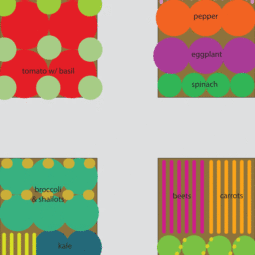I wanted to share some information about one in particular that I think you might enjoy seeing: the gardens at the Château Villandry in France. The pictures are from my professor’s presentation which he took during his visits to the site. I have been to Europe often and therefore have other places on my list to visit next, but this may just move France back up a notch on that list.
Overall I get a little stressed out with these highly stylized and organized French gardens. They are so tightly constricted and I am such a loose gardener when it comes to solid lines and separations of space. They intend to dominate and control nature, and yet I do envy them somewhat for their ability to organize and showcase particular plant materials If we look past those obscenely manicured boxwood and roses, there is something pretty special to be seen in the Kitchen Garden (pictured in the lower central terrace).
Although the Kitchen Garden is still very tightly organized, I find this a really enjoyable and inspirational space. It is perhaps one of the largest examples of a formal French kitchen garden. I just got done doing a local study on front yard vegetable gardens and wish I had included some reference to this particular garden. This is a great example of how beautiful and interesting a staple like vegetables can be in any landscape. Pairing contrasting colors and textures can really make a functional space dually breath-taking.
As we plan for our Spring gardens, consider how you can make your little plot more productive but also a more enjoyable space to be in. The more time we spend in our gardens, as a social space or a place of refuge, the more productive they will often become. We may spend what we think of as leisure hours there, but we are also occassionally pulling a weed or noticing aphids or snipping off lettuce flowers.
Enjoy the plant porn!








 Spring bed prep, the soil-building way!
Spring bed prep, the soil-building way! 
 Upgrade your hanging basket game!
Upgrade your hanging basket game!  Here’s
Here’s

 This cluster was about the siz
This cluster was about the siz



 I start with a
I start with a

Do the gardeners rotate the plots in the French Kitchen Gardens? For example, one year they grow leek and lettuce and the next they plant them in different plots.
I find certain vegetables grow really well in particular parts of my garden, like my tomatoes in the sunny spot. But, I know a healthy garden requires rotation. I wonder how Europeans manage garden rotations while keeping a strict organization.
I can see the attraction to such a well organised and planned garden, one that fits in with it’s environment (and I do love this about France). But I wonder if it can operate on the principles of permaculture? I wonder how you could create such an art form and still apply the permaculture principles?
I am not sure whether they rotate the crops, although I bet it wouldn’t be too hard since the area looks well exposed.
I’m too messy for this type of gardening, but I bet you could work in some permaculture methods by planting beneficial insect attracting plants in a bed next to other veggies. Or perhaps when you rotate crops, you strategically plant nitrogen fixers or mulch producers to maintain strong soil. You could have a bed just for the three sisters, or plant a dwarf fruit tree in the middle with a geometric ring of low shrubs around it. Fun to think about!